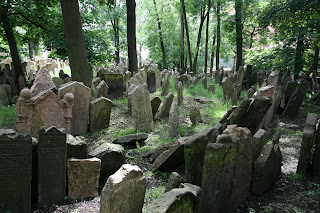 Our guide, Roman, in Old Jewish Cemetery
Our guide, Roman, in Old Jewish Cemetery Old Jewish Cemetery
Old Jewish CemeteryWe went on a guided tour of the Jewish Quarter with an English speaking guide, Roman. He was great! And well worth every kronin. We got to see the insides of several synagogues and the Old Jewish Cemetery. The Old New (as opposed to the New New) Synagogue is only used for high holy days and is a memorial to the Prague Jews who did not survive the war. Their names are handwritten on the interior walls with their birth and death dates. Some of them don’t have death dates because no one knows when they died – they just were taken away and never came back. Of the 120,000 Jews in Prague when the Nazis came into power 80,000 of them never came home.
When we were in Budapest SewDiva noticed small brass squares in the sidewalks in front of some of the doors in the ghetto but we didn’t know what they were for. Now, thanks to Roman, we do. They are part of an international remembrance project that has just begun. The squares are put in front of the doors where Jews lived who were taken and died. They are called “humble stones” because the names are not very large and so you have to bend over (assume the posture of humility) to read them.
There was a ghetto in Prague until the mid-1800’s (when it was urban-renewalized – torn down and rebuilt with fancy houses, the previous occupants having been thrown out). Until the late 1700’s there was only one Jewish Cemetery in Prague. It is about the size of three or four city lots and they estimate there are 100,000 bodies in there. Once it filled up they put people into another layer. The first layer they dug the graves 6’ deep, the second, third, fourth and in some places 5th and 6th layers they dug 4’ and added 2’ of soil to the top. So now the cemetery is one full floor higher than the streets around it.
We also got to go into a Baroque synagogue that is now the Jewish Museum. And the Spanish Synagogue, not named because Spanish Jews worshiped there but because it is decorated in the Moorish style, like the Alhambra palace in Spain. The interior decorations were beautiful. Of the 3 it is the only one that is still being used as a place of worship. You can tell because there is a lit oil lamp hanging in the front symbolizing the presence of God (I always wondered about the lamp in the front of Catholic churches: so Catholics out there let us know if it is the same symbolism).
When we were in Budapest SewDiva noticed small brass squares in the sidewalks in front of some of the doors in the ghetto but we didn’t know what they were for. Now, thanks to Roman, we do. They are part of an international remembrance project that has just begun. The squares are put in front of the doors where Jews lived who were taken and died. They are called “humble stones” because the names are not very large and so you have to bend over (assume the posture of humility) to read them.
There was a ghetto in Prague until the mid-1800’s (when it was urban-renewalized – torn down and rebuilt with fancy houses, the previous occupants having been thrown out). Until the late 1700’s there was only one Jewish Cemetery in Prague. It is about the size of three or four city lots and they estimate there are 100,000 bodies in there. Once it filled up they put people into another layer. The first layer they dug the graves 6’ deep, the second, third, fourth and in some places 5th and 6th layers they dug 4’ and added 2’ of soil to the top. So now the cemetery is one full floor higher than the streets around it.
We also got to go into a Baroque synagogue that is now the Jewish Museum. And the Spanish Synagogue, not named because Spanish Jews worshiped there but because it is decorated in the Moorish style, like the Alhambra palace in Spain. The interior decorations were beautiful. Of the 3 it is the only one that is still being used as a place of worship. You can tell because there is a lit oil lamp hanging in the front symbolizing the presence of God (I always wondered about the lamp in the front of Catholic churches: so Catholics out there let us know if it is the same symbolism).

Since you asked...:)
ReplyDeleteFor Catholics it symbolizes the presence of reserve sacrament (consecrated wafers and wine from a previous Mass that are kept there).
For Protestants who don't do reserve sacrament (i.e. most of them), it has similar symbolism to the synagogue...symbolizing the eternal presence/love of God.
Not sure if Orthodox do this or not, and if so what it symbolizes!